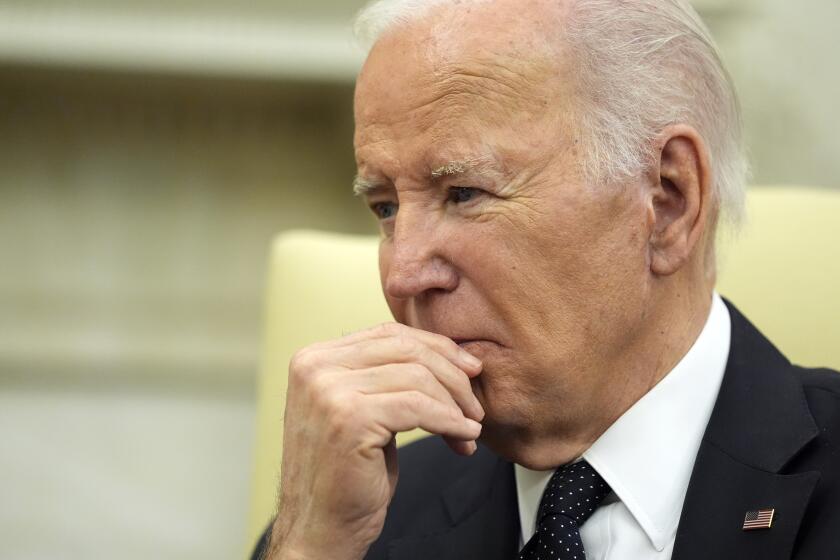Japan OKs Plan to Hike Spending and Imports
The Japanese Cabinet, responding to foreign criticism, approved a 12-month, $14.5-billion spending plan Tuesday designed to increase domestic economic growth and to help reduce the country’s still-expanding trade surplus.
But the plan was quickly criticized as inadequate, even by some members of Prime Minister Yasuhiro Nakasone’s Cabinet and by some other members of the ruling Liberal Democratic Party.
Foreign Minister Shintaro Abe predicted that U.S. officials would not give the program very high marks. Masayuki Fujio, the party’s policy board chairman, said the $2-billion increase in imports anticipated as a result of the program was “too small.”
The plan was the first departure, albeit a mild one, from the stringent belt-tightening policy that Nakasone has followed since becoming prime minister in November, 1982.
$19.1 Billion in Spending
Officials of the Economic Planning Agency predicted that the measures, including side effects, would create an additional $19.1 billion in domestic spending, the equivalent of 1.3% of the gross national product that Japan expects to achieve in fiscal 1985, which ends next March 31.
Kunio Miyamoto, deputy director of the agency’s coordination bureau, however, acknowledged that the measures, by themselves, are likely to induce only about $2 billion of imports. Japan’s trade surplus with the United States, which amounted to $36.9 billion last year, is heading toward $50 billion this year.
The measures, which committed the deficit-ridden national government itself to only $2.6 billion in new spending projects, were designed to respond to rising calls from such U.S. leaders as Secretary of State George P. Shultz for Japan to reduce its reliance upon exports for growth. Shultz made his first such appeal last March.
If Japan stimulates its domestic economy, the U.S. argument goes, Japanese consumers will have more money with which to buy imported goods, business concerns would have more to invest and the economy as a whole would be able to place less reliance on exports.
Sluggish Domestic Growth
Although the rate of increase in Japan’s exports has slowed (to a gain of only 1.7% in the first six months of this fiscal year), sluggishness in domestic growth has driven imports down by 7.5%, leaving Japan with an even greater global trade surplus than it recorded last year. Between April and September, the first half of fiscal 1985, the trade surplus set a record of $24.3 billion, based on merchandise that passed through customs, a 37% increase over the first half of fiscal 1984.
Miyamoto said the measures announced Tuesday will ensure that Japan achieves the 4.6% real growth that the government forecast for fiscal 1985. He also predicted that the government’s market-opening measures and its effort to strengthen the yen--being carried out in cooperation with four other leading industrial nations--will eventually stop the growth in Japan’s trade and current accounts surpluses.
However, he acknowledged that there will be a lag of at least six months before the surpluses begin to dwindle.
Nakasone is expected to cite the new program as evidence of his efforts to reduce Japan’s trade surplus when he travels to New York on Saturday to attend a special 40th anniversary meeting of the U.N. General Assembly. He is scheduled to meet President Reagan twice next week in New York.
The main elements of the measures announced Tuesday are policies designed to spur an extra $2.3 billion of housing construction and to induce local governments to issue bonds for sewage construction worth $3.7 billion within the next 12 months. Economists, however, expressed doubts that so much money would actually be spent.
The central government committed itself to spend another $4.7 billion on disaster relief projects, public works and in extra investment by government corporations. Of the $4.7 billion, however, the public works spending--of $2.1 billion--was described as “advanced” from next fiscal year to this year, implying that public works spending for fiscal 1986 might be reduced by that amount.
Utility firms, the government announced, have committed themselves to increase investments by $5.1 billion over the next three years, with $1.9 billion of that spending to be made in the next 12 months.
The Cabinet also set a target of stimulating more spending by Japan’s savings-minded consumers, but it mentioned only two reforms specifically: limits of 24 months on installment purchases of color television sets and 30 months on purchases of passenger cars will be lifted, the announcement said.
Banks, which until now have been forced to close down cash-dispensing machines during non-banking hours, now will be allowed to operate them after banking hours on weekdays and on Saturdays.
Miyamoto said previous government programs designed to spur economic growth had often resulted in export-oriented industries increasing their investments, which eventually led to even greater trade surpluses. But this time, he said, “we planned investments which will not backfire into exports.”
More to Read
Start your day right
Sign up for Essential California for news, features and recommendations from the L.A. Times and beyond in your inbox six days a week.
You may occasionally receive promotional content from the Los Angeles Times.






